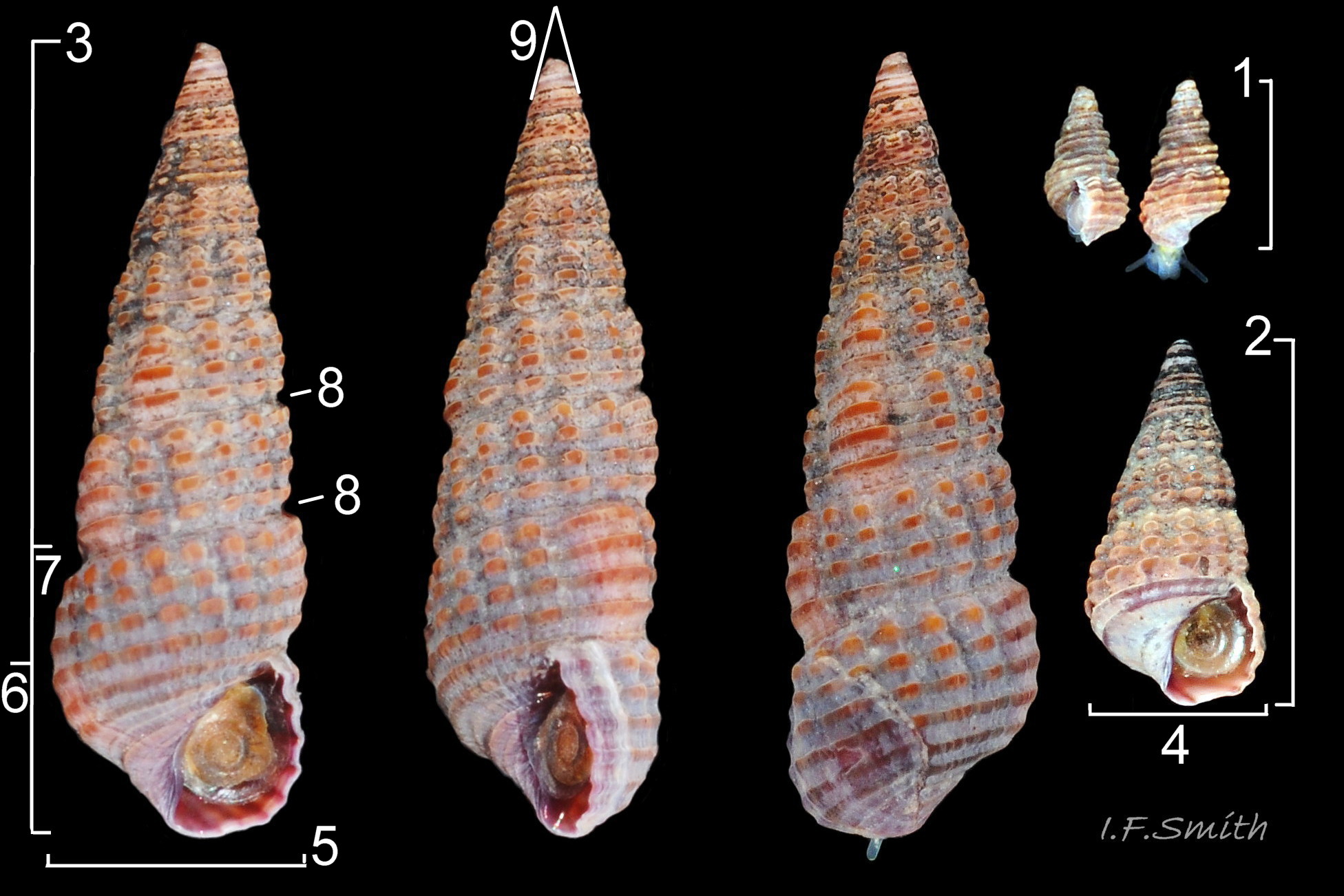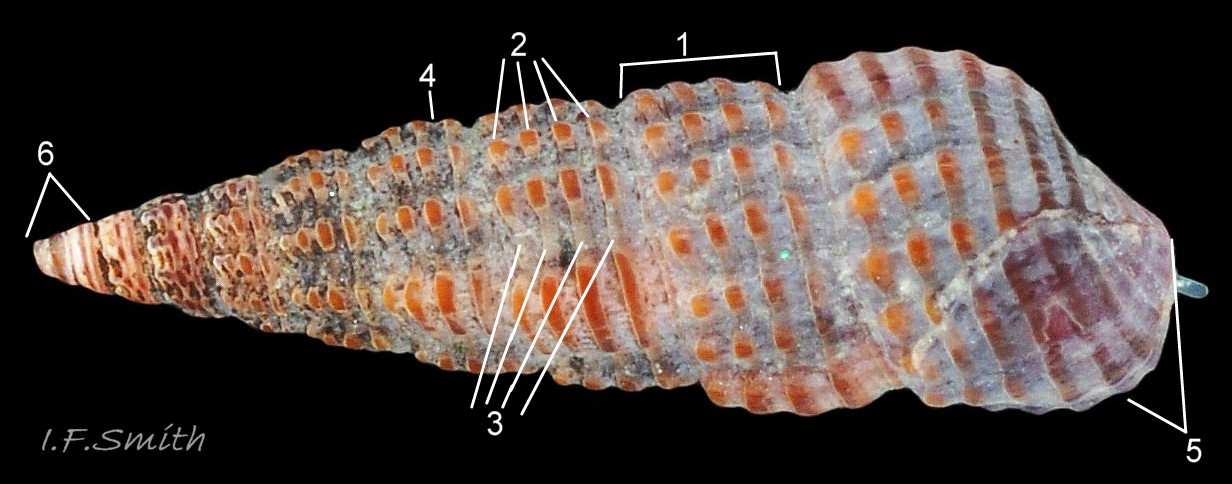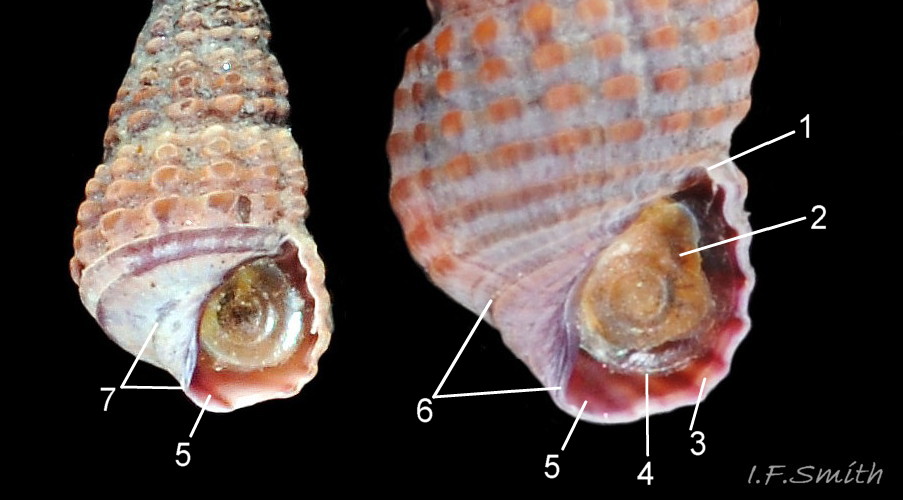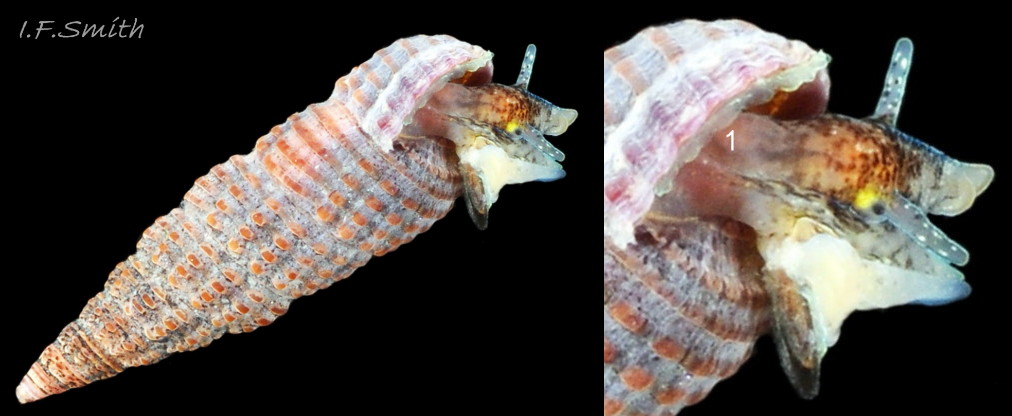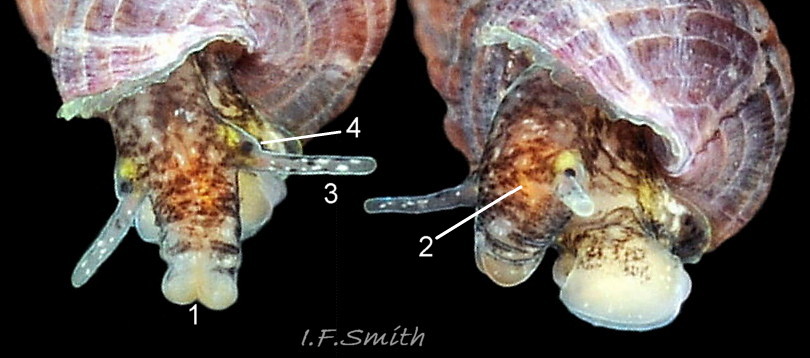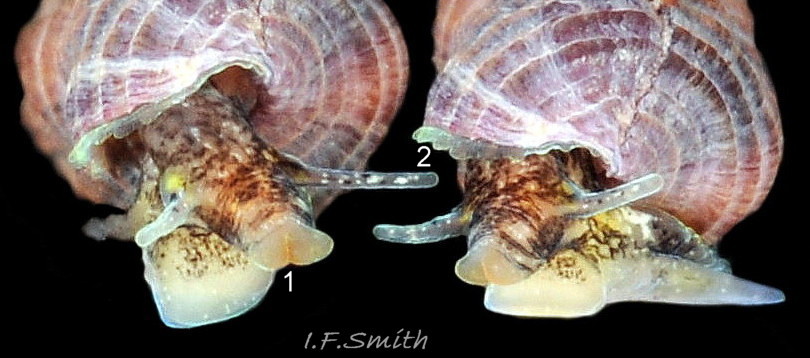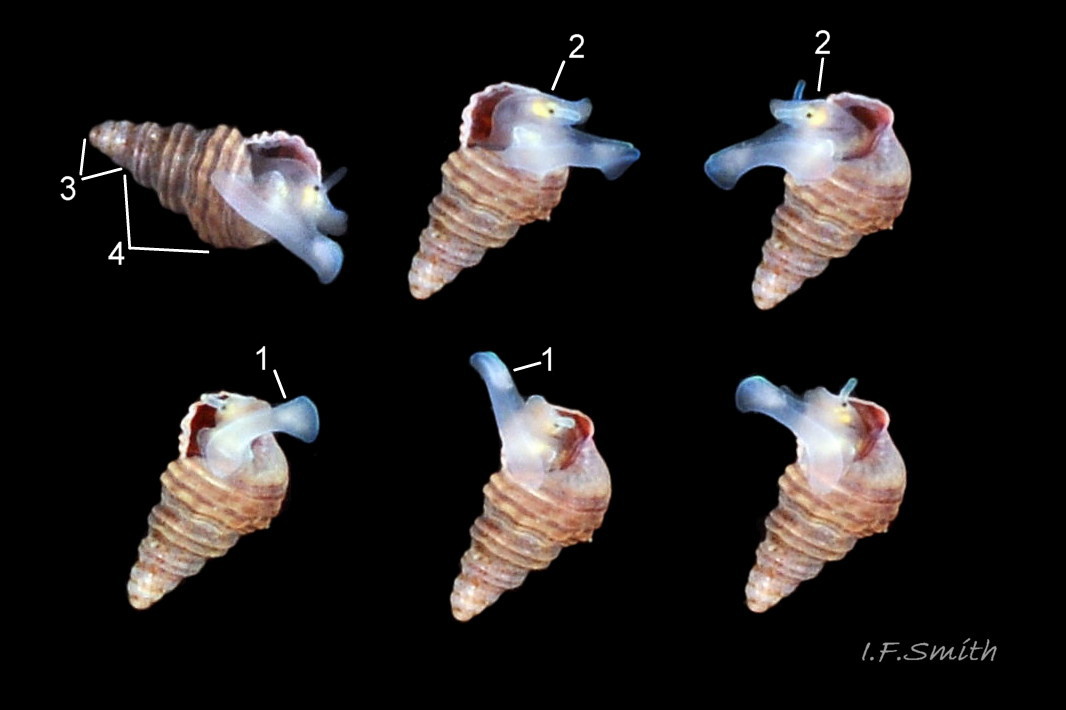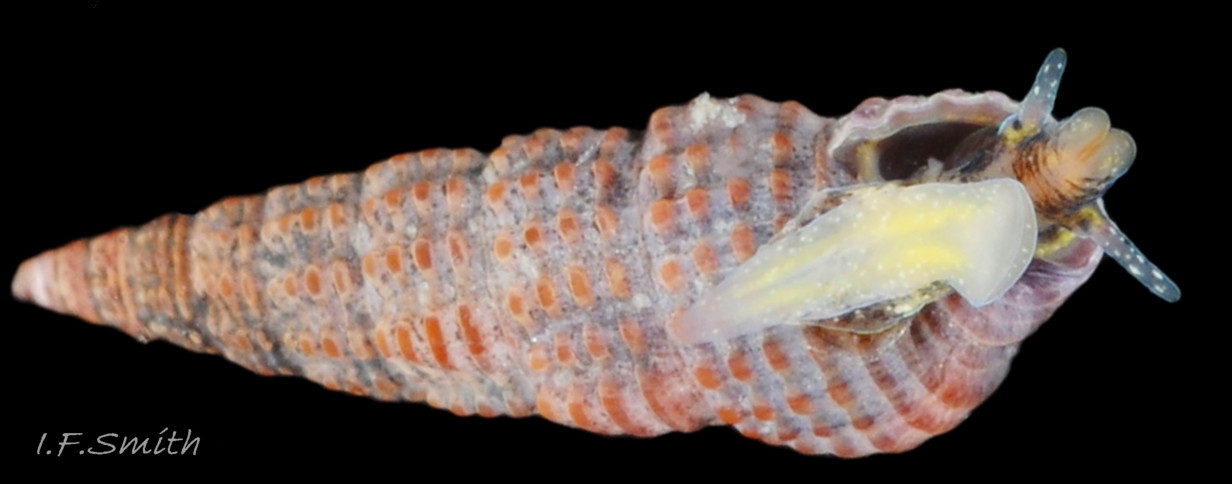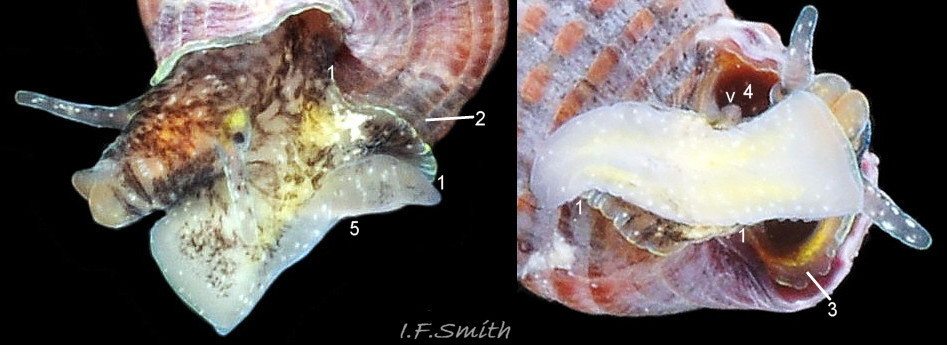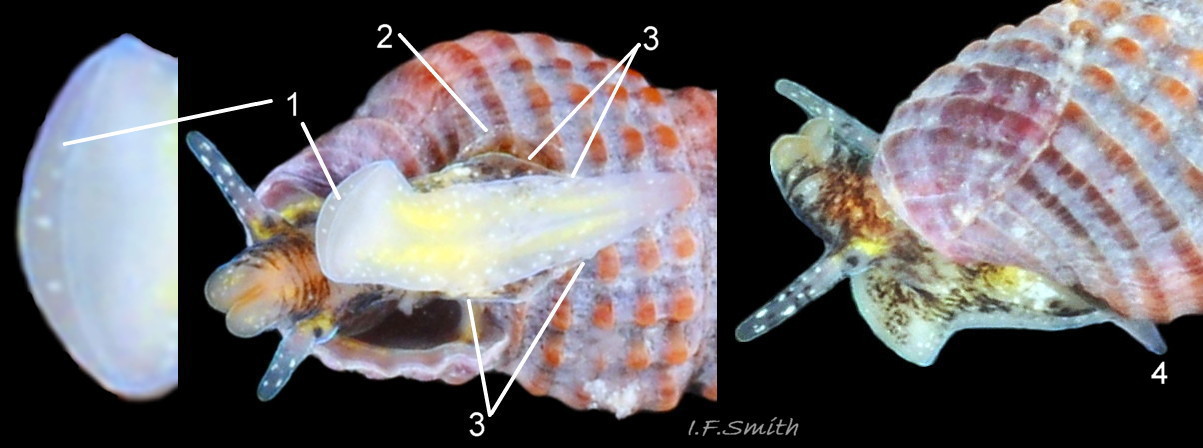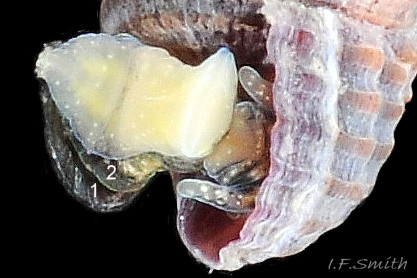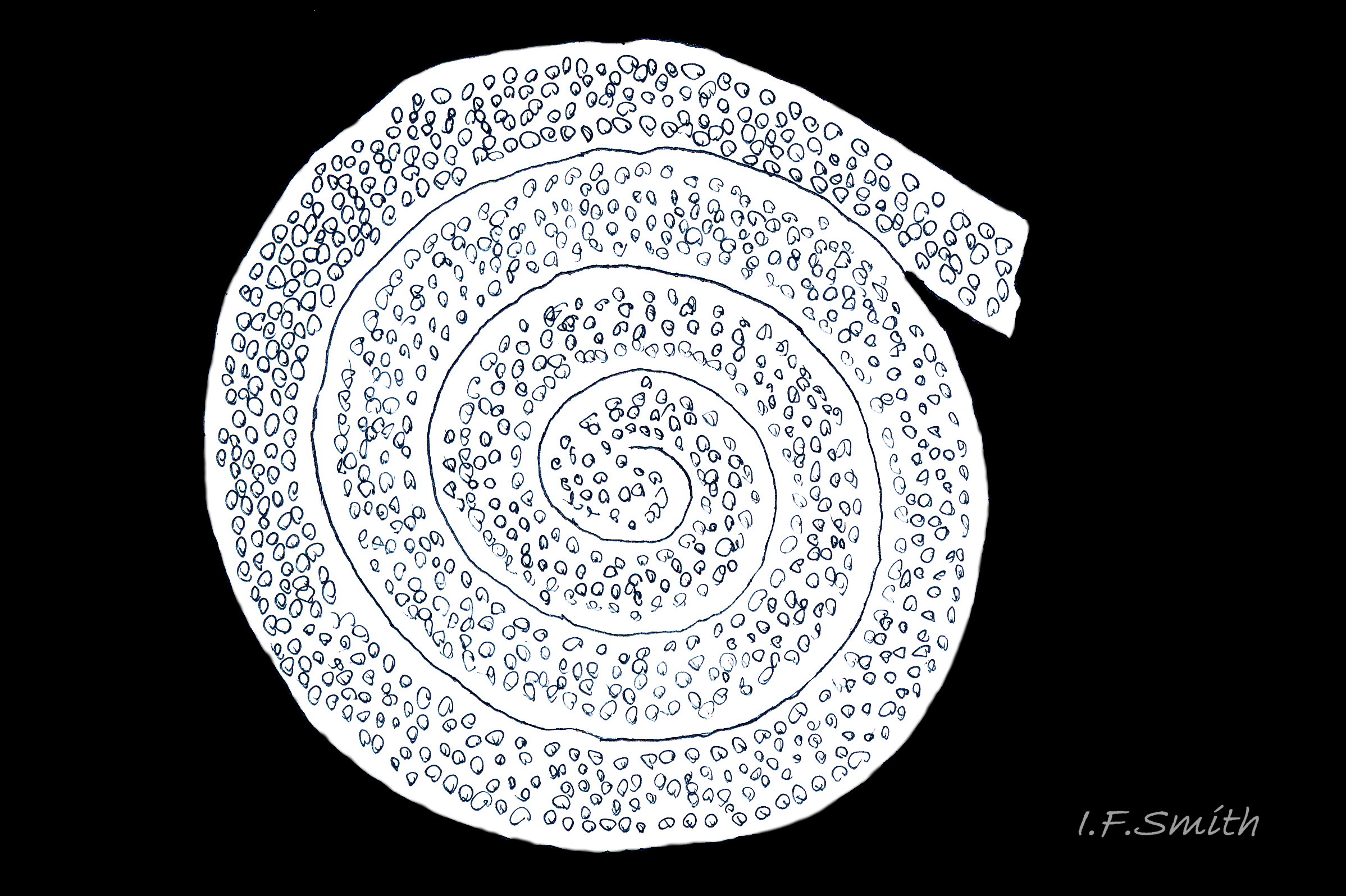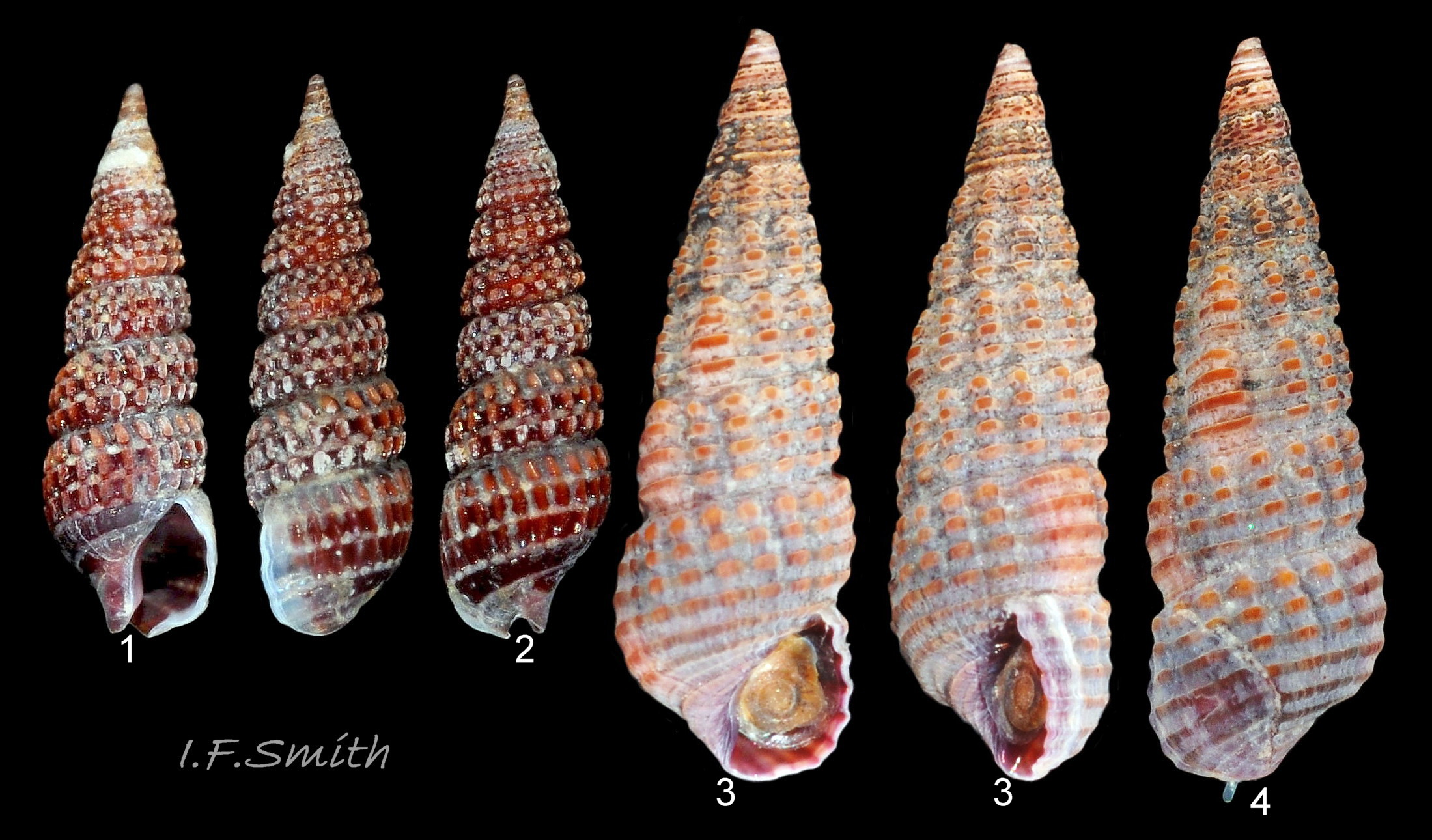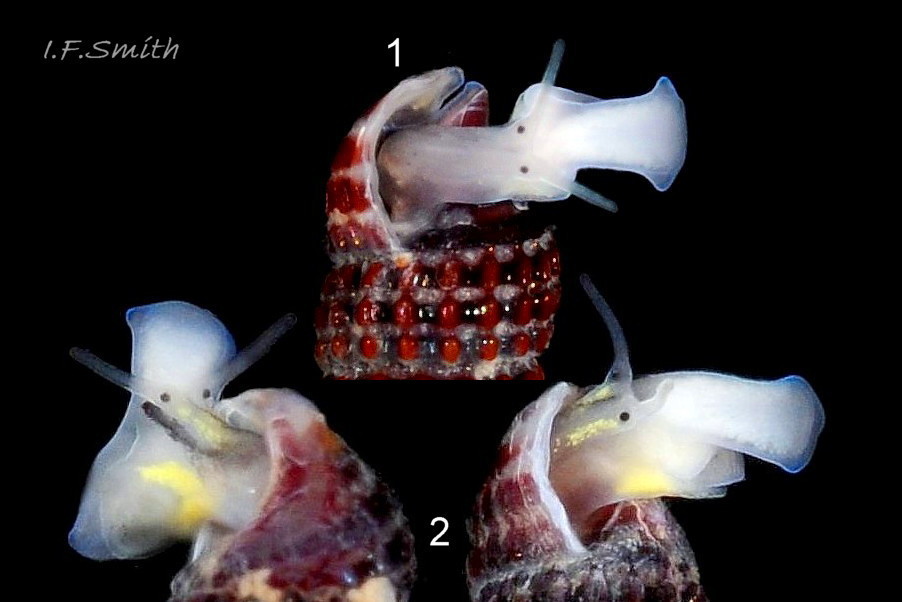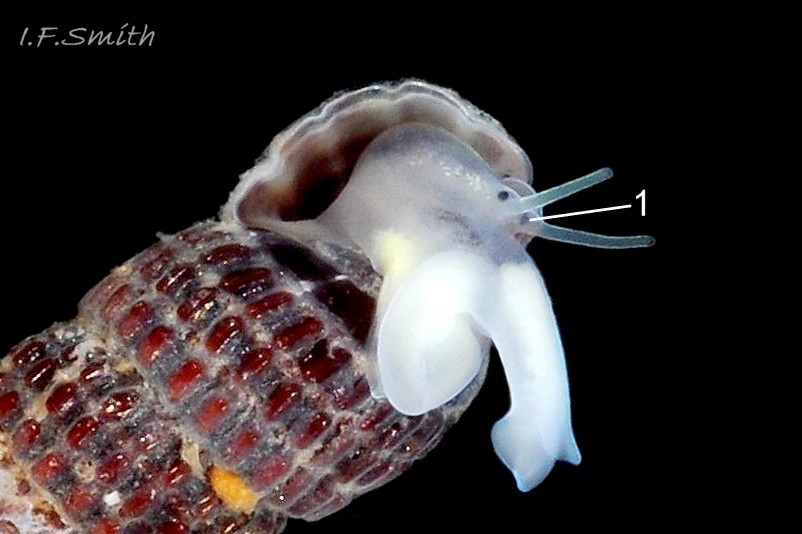Click image to enlarge with full caption. Main text below slider.
Bittium reticlatum (da Costa, 1778)
PDF available at www.researchgate.net/publication/349668602_Bittium_reticu…
Synonyms: Cerithium reticulatum (da Costa, 1778); Bittium atticum F. Nordsieck, 1977;
Vernacular: Needle whelk (English); Ebill môr (Welsh); naaldje (Dutch); Lille tårnsnegl (Danish); dvergtårnsnigel (Norwegian); nålsnäcka (Swedish);
GLOSSARY below.
Shell description
Usually up to 8mm high X 3mm broad, occasionally 15mm X 6mm 16 Bittium reticulatum . Solid shell with up to 12, exceptionally 15, slightly swollen whorls separated by sutures that appear deep as they coincide with furrows between spiral ridges 01 Bittium reticulatum
Profile: spire a tall, slender conoid; body whorl about 40% of shell height (range 36% to 48%. Breadth about 35% of height (when about 6mm high), but stouter when small (about 50% when 3mm high) 01 Bittium reticulatum . Apical angle about 30º.
Sculpture varies in strength geographically. The apical protoconch of 2.5 to 3 whorls is smooth 02 Bittium reticulatum. The earliest whorls of the teleoconch have two or three spiral ridges 07 Bittium reticulatum . Other whorls of spire usually have four spiral ridges 02 Bittium reticulatum and about 12 costae (range 9-16) that form steep-sided bosses where they intersect the ridges. Body whorl, in addition, has five or six spiral ridges without costae and bosses on its base. Furrows, about same width as ridges, contain microreticulation of growth lines and spiral striae which may also occur on the ridges, but usually worn off there.
Aperture small, height about 25% of shell height (range 22% to 34%) 01 Bittium reticulatum, lemon-shape, sometimes tending to rectangular 03 Bittium reticulatum. Adapical angle about 90º . No true siphonal canal, but a short, shallow, inhalent sinus is inclined to the left at the base of the columella. The palatal (outer) lip is thin, rounded and weakly crenulate. The glossy reddish interior of the aperture is fluted by grooves corresponding to the spiral ridges of the exterior. Columellar lip widely reflected; no umbilicus. Paretal lip a thin glaze on body whorl. The unobtrusive thin periostracum is light tan and the ground colour of the shell externally is opaque fawn to light chestnut-brown 02 Bittium reticulatum ; apex and columellar lip paler 02 Bittium reticulatum.The bosses are more glossy and brighter brown (or white) than intervening greyish areas. . Internally reddish 03 Bittium reticulatum. The oligogyrous spiracular operculum is approximately circular, light brown, with a subcentral nucleus and has a few well defined growth lines; its periphery is colourless transparent 03 Bittium reticulatum.
Body description
Ground colour translucent white heavily mottled with black/burnt umber and a little opaque white, combining with visible, internal, fawn-brown viscera to give an over all brown appearance to head and body 04 Bittium reticulatum. Large, pigmented snout with sparsely pigmented, widely-bifid tip; orange buccal mass visible 05 Bittium reticulatum. Mouth is a subterminal, ventral slit when shut 06 Bittium reticulatum. Linear, translucent white cephalic tentacles with sparse black and white marks. Basal swelling at posterior of each tentacle has visible internal yellow and bears a large black eye 05 Bittium reticulatum. Pigmentation on dorsum continues to posterior of tentacles on parts likely to be exposed to view, but ceases further back into shell 04 Bittium reticulatum. Recently metamorphosed juveniles, shell height 1.3mm 07 Bittium reticulatum, have almost no surface pigment on the translucent white body that clearly reveals the opaque-white, anterior pedal mucous gland and the yellow within the swollen tentacle-bases.
The length of the small foot is about 35% of shell height 08 Bittium reticulatum. Its anterior is broad and straight or slightly curved 09 Bittium reticulatum, tapering steadily to a rounded point at posterior 10 Bittium reticulatum. Heavy pigmentation on dorsal surface of foot does not extend onto its wide, translucent white, peripheral border that has only sparse opaque-white marks and very few blackish marks 09 Bittium reticulatum. Anterior of foot bilaminate, containing anterior pedal mucous gland 10 Bittium reticulatum& 07 Bittium reticulatum. Parts of the foot are yellow dorsally 09 Bittium reticulatum. A dark epipodium with papillate edge runs along each side of the foot 09 Bittium reticulatum. They unite to the posterior of the operculum and may protrude as a lobe beyond the posterior of the foot 10 Bittium reticulatum. They support, but do not enfold the edges of, the operculum 11 Bittium reticulatum. Sole translucent white with sparse opaque white spots and weakly defined, longitudinal yellow band either side of median furrow 10 Bittium reticulatum. Translucent white mantle protrudes as a lobed fringe from rim of aperture 06 Bittium reticulatum. The long, narrow mantle cavity with a long ctenidium follows the course of the tightly spiralled shell. The cavity may be near the minimum size needed for effective respiration. This may be the reason for the lack of a penis on males 04 Bittium reticulatum, and lack of swollen reproductive glands on females, which would obstruct respiratory currents (Fretter & Graham, 1962). Both sexes have an open pallial duct (prostate or oviduct) resembling those of primitive early molluscs. The female has a ciliated gutter leading from the mantle cavity to a large glandular ovipositor in the right side of the foot 09 Bittium reticulatum.
Key identification features
Bittium reticulatum
1: short, shallow, inhalent anterior sinus inclined to left at base of columella 13Br 13 Bittium reticulatum h. 6.2mm (right) compared with Cerithiopsis tubercularis h. 4.7mm (left). Llŷn Peninsula and Menai Strait, North Wales. .
2: head and body heavily mottled black/burnt umber and opaque white4Br 04 Bittium reticulatum. Shell height 6.2 mm. Llŷn Peninsula, North Wales. March 2016. . Very small juveniles lack pigment 7Br 07 Bittium reticulatum. Height 1.3 mm. Llŷn Peninsula, North Wales. September 2015. .
3: large snout with widely-bifid tip 05 Bittium reticulatum.
4: tentacles translucent white with some black and opaque white marks 05 Bittium reticulatum, sometimes orange or reddish.
5: widespread around Britain and Ireland, except North Sea and N.E. Irish Sea.
Similar species
Bittium simplex (Jeffreys, 1867)
nature22.com/estran22/mollusques/gasteropodes/gasteropode…
1: inhalent anterior sinus, as B. reticulatum.
2: body translucent white, tinted faintly pink in parts.
3: snout large and bifid, as B. reticulatum.
4: tentacles rose pink .
5: southern species, northern limit Channel Islands and perhaps Scilly Isles in Britain.
Cerithiopsis tubercularis (Montagu, 1803)
1: deep siphonal notch, resembling siphonal canal of Neogastropoda, inclined to left at base of columella 13 Bittium reticulatum.
2: body translucent white, some with variable amounts of black or yellow, usually in discrete areas, not randomly intermixed mottling 14 Bittium reticulatum.
3: no snout. Like Neogastropoda, has proboscis hidden in head when not feeding 15 Bittium reticulatum album.
4: tentacles translucent white 14 Bittium reticulatum.
5: as B. reticulatum5.
Habits and ecology
LWST, shallow sublittoral and to 250m depth. Can tolerate low salinity, 20‰ in Isefjord, Denmark. Most frequent on soft substrate with Zostera rooted in it, or soft substrate with some stones, shells etc with algae growing on them. Occasionally on rock surfaces, in crevices or boulders near soft substrate. In Isefjord, live mainly on soft substrate, but climb Zostera to lay spawn on it. Gregarious when numbers permit.
Feeds by grazing some or all (authors differ) of sponges, diatoms, foraminfera, filamentous algae and organic detritus from substrate with its radula. Elongate oval faecal pellets often have a protruding tail of sponge spicules. Breeds when water temperature reaches about 10ºC in late spring in Isefjord (Rasmussen, 1973). Fertilization internal; but, in the absence of a penis, mechanism unknown. Fretter & Graham (1981), postulated approximation of male and female mantle cavities, and transfer of sperm from open sided prostate to open pallial oviduct by male’s exhalent, and female’s inhalent, respiratory currents. Female has a ciliated groove that may be a “sperm collecting gutter”. Uniquely among British prosobranch gastropods, the spawn is laid on weed, stone or rock as a gelatinous cylinder about 25mm long, containing about 1000 ova, wound in a tight spiral of two to four turns and up to 3mm in diameter 12 Bittium reticulatum. A single female may lay 10,000 ova in seven lots over a two week period (Vinogradova, 1950). Eggs hatch into planktonic, slightly lopsided, 0.2mm diameter veligers with the right circular velar lobe slightly larger than the left. By metamorphosis, the diameter of the shell is about 0.3mm, and it has 2.5 to 3 whorls and a square tongue-shaped beak on the outer lip. Veligers of this species were reported in the past as common, or the dominant element (Limfjord) of the plankton, after breeding but this may no longer be the case. Growth and life-cycle after settlement in Isefjord was recorded by Rasmussen (1973) as: October 2mm to 2.5mm; no growth in winter; April/May 4mm to 5mm; June/July growth pause during first spawning; August 5mm to 6mm; second October 6mm to 7mm; no growth in second winter; second April/May 7mm to 8mm; second June/July cease growth while spawn and then die. In other geographical areas the timing, sizes and events vary, but finds in North Wales accorded with the Isefjord pattern:
a) 1.3mm in September 2015 07 Bittium reticulatum & 01 Bittium reticulatum, intermediate between metamorphosis in summer at 0.3mm and Isefjord 2mm to 2.5mm in October.
b) 2.9mm and 6.2 mm 01 Bittium reticulatum in March 2016, suggesting start of spring growth of first and second year specimens.
ln the Black Sea, breeding is May to August with veligers in the plankton June to December. In the western Mediterranean, breeding is March to July with veligers May to July. (Fretter & Graham, 1981).
Distribution and status
Currently B. reticulatum lives from the Black Sea, Mediterranean and Canary Islands to the Lofoten Islands and Kiel Bay in the Baltic, but not in the north east Irish Sea or North Sea further south than Orkney and Limfjord, Denmark. There are widespread records in Britain and Ireland, mostly of dead shells. Forbes & Hanley (1853) wrote “This species is found very abundantly in many localities …. It occurs at low-water-mark very abundant, living among Zostera in the Laminarian zone.”. Living examples are very much less common now in Britain, and some experienced shore workers have never seen it alive, though numerous dead shells persist where it formerly lived and account for the great majority of modern records 16 Bittium reticulatum. No live ones have been seen in the Netherlands since the 1930s when disease destroyed the Zostera. Numbers of live ones vary from year to year at individual sites. The current distribution is obscured by multiple records of old dead shells and obviously erroneous inland records on GBIF map www.gbif.org/species/9790747 distribution. U.K. map NBN species.nbnatlas.org/species/NBNSYS0000174135
Acknowledgements
I thank Florence and Marc Cochu, and Julie Peeling for use of their images.
Links and references
Cochu, F. & Cochu, M. (accessed February 2021). Estran 22, faune et flore de le zone de la balancement de marées en Côtes d’Armor
nature22.com/estran22/mollusques/mollusques.html
Costa, E.M. da. 1778. Historia naturalis testaceorum Britanniae or, The British conchology. London.
Forbes, E. & Hanley S. 1849-53. A history of the British mollusca and their shells. vol. 3 (1853), London, van Voorst. (As Cerithium reticulatum; Free pdf at archive.org/stream/historyofbritish03forb#page/192/mode/2…
Fretter, V. and Graham, A. 1981. The prosobranch molluscs of Britain and Denmark. Part 6 Cerithiacea to Heteropoda. Suppl. 9, J. Moll. Stud. .
Fretter, V. and Graham, A. 1962. British prosobranch molluscs: their functional anatomy and ecology. London, Ray Society.
Fretter, V. and Graham, A. 1994. British prosobranch molluscs: their functional anatomy and ecology. Revised edition. London, Ray Society.
Graham, A. 1988. Molluscs: prosobranch and pyramidellid gastropods: keys and notes for the identification of the species. Leiden. Brill & Backhuys, for Linn. Soc. Lond. & Estuarine and Brackish-water Sciences Assoc. Synopses of the British Fauna (New Series) no.2. Edition 2 (662pages).
Hayward, P.J. & Ryland, J.S. (eds.) 1990. The marine fauna of the British Isles and North-West Europe vol. 2 . Oxford, Clarendon Press.
Houbrick, R.S. 1993. Phylogenetic relationships and generic review of the Bittiinae (Prosobrachia, Cerithioidea). Malacologia 35: 261-313
www.biodiversitylibrary.org/page/13149462#page/283/mode/1up
Jeffreys, J.G. 1862-69. British conchology. vol. 4 (1865). London, van Voorst. (As Cerithium reticulatum; Free pdf at archive.org/stream/britishconcholog04jeff#page/258/mode/2… . Use slide at base of page to select pp. 258 to 261.
Rasmussen, E. 1973. Systematics and ecology of the Isefjord marine fauna (Denmark). Ophelia, 11, 1-495.
Thorson, G. 1946. Reproduction and larval development of the Danish marine bottom invertebrates. i Meddelelser fra Kommissionen for Danmarks Fiskeri- og Havundersøgelser, Serie Plankton 4: 1-523.
Vinogradova, Z.A. 1950. Materials concerning the biology of Black Sea molluscs. Trudy karadahs’koyi nauchnoyi stanstiyi T.I. Vyazems’koho 9: 100 to 158. (In Fretter & Graham, 1981.)
Current taxonomy: World Register of Marine Species (WoRMS) www.marinespecies.org/aphia.php?p=taxdetails&id=139054
Glossary
abapical/adapical = away from/towards the apex of the shell.
aperture = mouth of gastropod shell; outlet for head and foot.
cephalic = (adj.) of or on the head.
cilia = (pl.) vibrating linear extensions of membrane used in feeding or locomotion. (“cilium” singular).
ciliated = (adj.) coated with cilia.
columella = axis of gastropod shell spiral, exposed on final whorl by aperture.
columellar = (adj.) of or near central axis of spiral gastropod.
columellar lip = lower (abapical) part of inner lip of aperture.
conoid = approximately conical in shape.
costa = (pl. costae) rib crossing a whorl of a gastropod shell at about 90° to direction of coiling and any spiral ribs or lines.
ctenidium = comb-like molluscan gill; usually an axis with a row of filaments either side.
diatom = microscopic aquatic alga with siliceous cell-walls.
ELWS = extreme low water spring tide (usually near March and September equinoxes).
epipodium = (pl. epipodia) collar or circlet running round sides of foot of some gastropods, bearing bosses, lobes and/or tentacles.
height = (of gastropod shells) distance from apex of spire to base of aperture along axis of coiling.
mantle = sheet of tissue that secretes the shell and forms a cavity for the gill in most marine molluscs.
Neogastropoda = carnivorous gastropods with extensile proboscis, and a siphonal canal in the shell.
oligogyrous = (of a spiral) having few turns.
opercular = (adj.) of the operculum.
operculum = plate of horny conchiolin used to close shell aperture.
palatal lip = outer lip of gastropod aperture.
pallial = (adj.) of, relating to, or produced by the mantle. (Pallial duct is a duct attached to the inner surface of the mantle cavity).
papilla = (pl. papillae) small, nipplelike, sensory protruberance.
papillate = bearing papillae.
plankton = animals and plants that drift in pelagic zone (main body of water).
parietal lip = upper part of inner side of gastropod aperture, often lacking clear lip structure with just a glaze on side of whorl adapically of columellar lip.
protoconch = apical whorls produced during embryonic and larval stages of gastropod; often different in form from other whorls forming teleoconch.
sinus = elongate cavity or hollow.
striae = (sing. stria) usually parallel, slight, fine or narrow furrows, ridges, stripes, or streaks.
subterminal mouth = a mouth which is posterior to the tip of the snout.
suture = groove or line where whorls of gastropod shell adjoin.
teleoconch = entire gastropod shell, apart from apical protoconch.
umbilicus = cavity up axis of some gastropods, open as a hole or chink on base of shell, often sealed over.
veliger = shelled larva of marine gastropod or bivalve mollusc which swims by beating cilia of a velum (bilobed flap).
